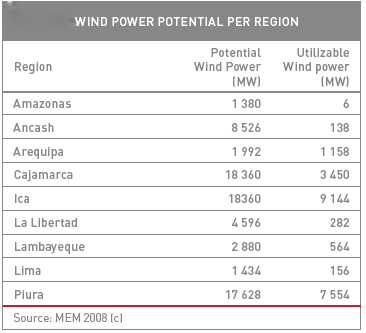Knowledge fuels change
For over a decade, Energypedia has shared free, reliable energy expertise with the world.
We’re now facing a serious funding gap.
Help keep this platform alive — your donation, big or small, truly matters!
Thank you for your support
Wind Energy Country Analyses Peru
Wind energy potential
Due to its geography Peru possesses abundant wind energy potential. Mainly along the coastline and the primary mountain range there are wind speeds of 7.5 m / s and more (at a height of 80 meters) which enable an economically viable utilization. The regions with the most abundant wind energy potential are situated in the North at the coast as well as in the Andes and around Ica south of Lima. In the west of the Andean Mountains and towards the Amazon basin there is hardly any wind potential. The overall potential of onshore wind power is estimated at 77 GW in the wind atlas published at the end of 2008 (http: // dger.minem.gob.pe / AtlasEolico / atlaseolicolibro / AtlasEolicoLibro.pdf ). The technologically feasible potential for electricity generation is officially estimated at 22 GW by MEM. This is based on a study for the Wind Atlas for Peru (Atlas Eólico del Perú) issued in November 2008 which by means of about 30 measuring stations established an overview of the Peruvian wind power potential. Since large scale experience on the utilization of wind power is not existent yet and precise measurements at certain project sites have not been conducted yet, the actual values might differ. The potential for offshore wind power along the Peruvian coast has not been researched yet in depth. Out of the 25 regions of Peru nine show a wind power potential worth mentioning. The following table shows the regions with a wind power potential of more than 1 000 MW and the respective utilizable wind power. The table clearly shows that the highest yields are achievable at the coastal regions of Piura in the Northwest and Ica in the South of Lima. The third most promising region is Cajamarca in the northern Peruvian Andes. The wind regime is best during winter with wind speeds dropping in summer. This seasonal variation matches well with availability of water resources for hydro power generation that is highest in summer and low in winter. Therefore, if provisions for an intelligent dispatching system are made, RES could provide a year round supply of electricity.
Framework Conditions for Wind Energy
The general instruments for the promotion of renewable energy sources are defined in the Law N° 1002 as described in chapter 1.5. The major elements of the law can be summarized as follows: • Share of renewable energy such as wind, solar, tidal, geothermal, biomass and hydro of at least 5 % for the first five years (2008-2012)
- Higher tariff prices that will be set by OSINERG
- Guaranteed and preferential feed-in
In order to promote renewable energy generation, the Peruvian government launched a package of measures to encourage investments in the area. Its main features comprise a guaranteed internal rate of return of 12 % and accelerated depreciation up to 20 % per year. In order to build a wind farm a temporary license from the Dirección General de Energía of the Ministry of Energy is required, which includes the permission to conduct the Environmental Impact Assessment (EIA), prefeasibility studies and wind measurements. The permanent license will only be issued on basis of an EIA. Once the EIA is approved and a permanent concession is obtained, the wind farm can be erected.
Current Use of Wind Energy and Project Pipeline
Regarding small scale wind power applications several small wind turbines are in operation mainly in rural areas for water pumping, irrigation and battery charging. The use of wind energy for water pumping has been taking place traditionally in the North of Peru. As far as large scale wind installations are concerned, two turbines were installed in the late 1990s, but there was no further development of wind power utilization until 2007. However, since then a rush for temporary concessions has taken place to secure attractive potential wind farm sites adding up to a total capacity of more than 10 GW. 15 Table 11 shows the number of projects with temporary licenses per region. The planned capacities of the wind parks range from 40 to 300 MW. It is important to emphasize that all the temporary concessions obtained so far are for sites close to the coastline because access is easier and wind turbines can be delivered by sea vessel. Taking into account the large number of projects and the




















